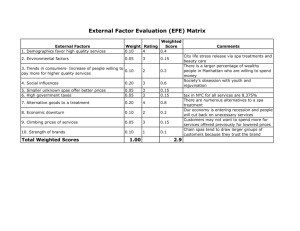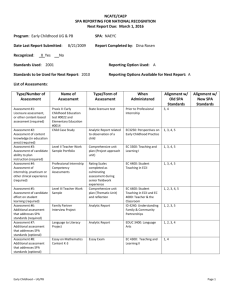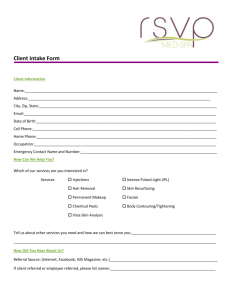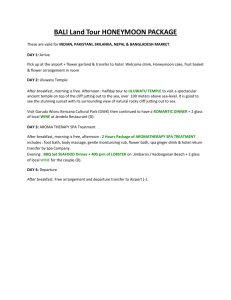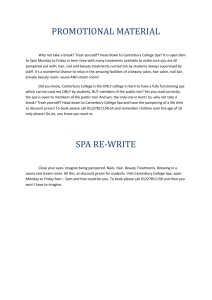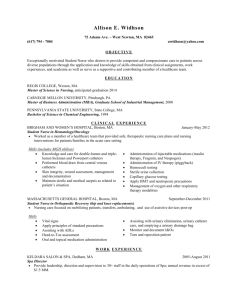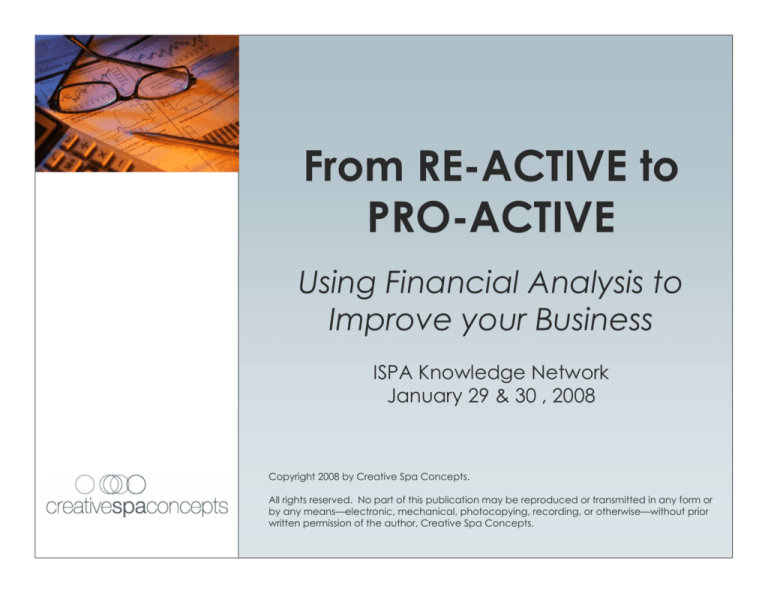
From RE-ACTIVE to
PRO-ACTIVE
Using Financial Analysis to
Improve your Business
ISPA Knowledge Network
January 29 & 30 , 2008
Copyright 2008 by Creative Spa Concepts.
All rights reserved. No part of this publication may be reproduced or transmitted in any form or
by any means—electronic, mechanical, photocopying, recording, or otherwise—without prior
written permission of the author, Creative Spa Concepts.
Expanded View of
Accounting System
Information Needs
of Decision
Makers
Financial
Data
Copyright © 2008 Creative Spa Concepts
All Rights Reserved
Accounting
System
Periodic
Financial
Statements
Decision
Makers
Informed and
Rational
Economic
Decisions
Key Inputs for Spa
Accounting
• Revenues from services provided
and merchandise sold
• Payments of employee salaries,
wages and benefits
• Payments of expenses
• Costs of goods
• Undistributed Costs
• Fixed Costs
Copyright © 2008 Creative Spa Concepts
All Rights Reserved
Key Components for
Spa Accounting System
•
•
•
•
•
•
Copyright © 2008 Creative Spa Concepts
All Rights Reserved
Accounts
Chart of accounts
General ledger
General journal
Other journals and ledgers
Accounting cycle
Primary Output for Spa
Accounting System
To make the most effective use of financial
statement data, decision makers apply
various analytical techniques to that data,
including;
• Preparation of common-sized financial
statements
• Ratio analysis
• Trend analysis
Copyright © 2008 Creative Spa Concepts
All Rights Reserved
Common Financial
Statements
• Income Statement
• Balance Sheet
• Statement of Cash Flows
Copyright © 2008 Creative Spa Concepts
All Rights Reserved
Income Statement
Components
•
•
•
•
•
•
•
Net Revenue
Cost of Goods
Direct Expenses
Indirect Expenses
Undistributed Operating Expenses
Fixed Charges
Depreciation, Amortization, Interest Expense
and Income Taxes
• Net Income
Copyright © 2008 Creative Spa Concepts
All Rights Reserved
Revenue Components
•
•
•
•
•
•
•
•
•
Copyright © 2008 Creative Spa Concepts
All Rights Reserved
Spa Services
Salon Services
Fitness Services
Health and Wellness
Medical Services
Membership and Fees
Retail
Rentals and Other
Food and Beverage
Cost of Goods Sold
•
•
•
•
•
•
•
•
Copyright © 2008 Creative Spa Concepts
All Rights Reserved
Cost of Retail Products
Cost of Professional Products
Cost of Food and Beverage
Salaries and Wages
Commission
Payroll Taxes and Benefits
Independent Contractor Fees
Expenses directly related to the
performance of service or sale of
product
Payroll
• Salaries and Wages
• Commission
• Payroll Taxes and WC
• Benefits
Copyright © 2008 Creative Spa Concepts
All Rights Reserved
Salaries and Wages
Spa Positions
•
•
•
•
•
•
•
•
•
Copyright © 2008 Creative Spa Concepts
All Rights Reserved
Management and Supervisors
Technicians
Receptionists
Attendants
Housekeeping
Fitness
Stylists
Nail Technicians
Medical Staff
Direct or Indirect
• Expenses are either direct or indirect
depending on the service performed
or product sold
• Differentiated in order to understand
where the cost occurred
Copyright © 2008 Creative Spa Concepts
All Rights Reserved
Expenses
•
•
•
•
•
•
•
•
•
Copyright © 2008 Creative Spa Concepts
All Rights Reserved
Ambience
Contract Services
Dues and Subscriptions
Equipment Rental
Guest Supplies
Hospitality
Independent Contractor Fees
Laundry
Linen
Expenses
•
•
•
•
•
•
•
•
•
Copyright © 2008 Creative Spa Concepts
All Rights Reserved
License and fees
Operating Supplies
Professional Development
Salary and Wages
Telecommunications
Travel
Uniforms
Others
These expenses can crossover
depending on what revenue source
Undistributed Operating
Expenses
• General and Administrative
• Marketing
• Facility Maintenance and Utilities
Copyright © 2008 Creative Spa Concepts
All Rights Reserved
Undistributed Operating
Expenses
General and Administrative Expenses
• Payroll and Related
• Accounting Expenses
• Other Expenses
Copyright © 2008 Creative Spa Concepts
All Rights Reserved
General and
Administrative Expenses
Accounting Expenses
• Audit Expenses
• Payroll Processing
Copyright © 2008 Creative Spa Concepts
All Rights Reserved
General and Administrative
Expenses
Other Expenses
• Bank Charges
• Cash Over/Short
• Credit and Collection
• Credit Card Commissions
• Dues and Subscriptions
• Human Resources
• Information Systems
Copyright © 2008 Creative Spa Concepts
All Rights Reserved
General and Administrative
Expenses
Other Expenses
• Legal and Professional
• License and Fees
• Loss and Damage
• Meals and Entertainment
• Operating Supplies
• Postage
• Professional Development
• Travel
Copyright © 2008 Creative Spa Concepts
All Rights Reserved
Undistributed Expenses
Marketing Expenses
• Payroll and Wages
• Other Expenses
–
–
–
–
–
–
Copyright © 2008 Creative Spa Concepts
All Rights Reserved
Advertising
Agency Fees
Collateral
Comp Guests
Direct Mail
Promotions
Undistributed Expenses
Facility Maintenance and Utilities
• Payroll and Wages
• Utilities
• Other Expenses
–
–
–
–
–
–
–
–
Copyright © 2008 Creative Spa Concepts
All Rights Reserved
Building
Contract Services
Equipment Rental
Equipment Repair
Landscaping
Operating Supplies
Trash Removal
HVAC
Fixed Expenses
•
•
•
•
•
Copyright © 2008 Creative Spa Concepts
All Rights Reserved
Insurance
Management Fees
Rent
Real Estate
Personal Property Taxes
Other Expenses
•
•
•
•
Copyright © 2008 Creative Spa Concepts
All Rights Reserved
Depreciation
Taxes
Interest Expense
Amortization
Income Statement
Defined
• A report that reflects the RESULTS of
operations for a period of time.
• When the statement reflects a net
loss, it is called a Statement of
Operations.
• Degree of detail is somewhat
discretionary, but should include
revenue, expenses, interest,
depreciation and taxes UNLESS
amounts are insignificant.
• Format will depend on who is using
the report.
Copyright © 2008 Creative Spa Concepts
All Rights Reserved
Income Statement
Defined
• External users such as owners, investors and
creditors will use the Income Statement that is
relatively brief, providing only a summary detail
about the results of operations.
• Internal user’s such as General Manager will use a
much more comprehensive income statement
detailing revenues and expenses from various
departments.
• The internal user’s such as Director’s and
Manager’s will use a Departmental Income
Statement.
• The Income Statement can also be referred to as
the Profit and Loss Statement or P & L
• The Departmental P & L will usually not include
interest, depreciation, and taxes.
Copyright © 2008 Creative Spa Concepts
All Rights Reserved
Statement of Cash
Flows Defined
• A report that summarizes the change in
Cash and Equivalents over a period of
time.
• The Cash Flow Statement shows how
the company is paying for its operations
and future growth, by detailing the
"flow" of cash between the company
and the outside world; positive numbers
represent cash flowing in, negative
numbers represent cash flowing out.
Copyright © 2008 Creative Spa Concepts
All Rights Reserved
Period 1
Beginning Cash Balance
Period 2
Period 3
Period 4
Total
$
-
$
(27,887)
$
(30,276)
$
(35,973)
$
(94,137)
Accounts Receivable
$
-
$
-
$
-
$
-
$
-
Sales Receipts
$
Loan Proceeds
$
Other
$
Cash In-Flows (Income)
66,023
$ 111,607
$ 105,950
$ 131,406
$ 414,985
-
$
-
$
-
$
-
$
-
-
$
-
$
-
$
-
$
-
Total Cash In-Flows
$
66,023
$ 111,607
$ 105,950
$ 131,406
$ 414,985
Available Cash Balance
$
66,023
$
83,720
$
75,674
$
95,433
Cost of Goods Sold
$
4,285
$
7,754
$
7,346
$
9,182
$
Salary and Wages
$
37,307
$
48,893
$
47,820
$
53,817
$ 187,836
Independent Contractors
$
7,801
$
12,432
$
11,887
$
14,339
$
Operating Expenses
$
28,317
$
28,716
$
28,394
$
29,745
$ 115,173
$
77,710
$
97,796
$
95,447
$ 107,084
$ 378,036
$
$
Cash Out-Flows
Subtotal
28,566
46,460
Other Cash Out-Flows
Capital Purchases
$
Loan Repayment
$
11,100
$
11,100
$
11,100
$
11,100
$
44,400
Owners Draw
$
5,100
$
5,100
$
5,100
$
5,100
$
20,400
Other
$
Subtotal
-
-
$
$
-
16,200
$
$
16,200
$
16,200
$
-
$
Total Cash Out-Flows
$
93,910
$ 113,996
$ 111,647
$ 123,284
$ 442,836
Ending Cash Balance
$
(27,887)
$
$
$
$ (121,987)
(27,851)
$
-
16,200
(35,973)
$
-
$
(30,276)
$
-
64,800
Balance Sheet Defined
• Reflects the financial position of an
operation by revealing assets,
liabilities, and owners’ equity as of
a given date.
Copyright © 2008 Creative Spa Concepts
All Rights Reserved
Balance Sheet Defined
Simply stated…
• Assets – Represent things owned
by the spa
• Liabilities – Claims to the assets of
outsiders
• Owners’ Equity – Claims of the
owners to the assets of the spa
Copyright © 2008 Creative Spa Concepts
All Rights Reserved
Balance Sheet Defined
Simply stated…
Assets = Liability + Equity
Copyright © 2008 Creative Spa Concepts
All Rights Reserved
How do these reports help
us make decisions?
• Financial reports provide information
about the performance or status of an
operation for a given period of time
• Used to measure ourselves against set
financial goals
• The information can be analyzed and
compared to other departments, spas,
industry averages, and like-businesses
• Data can be compared to the past to
determine overall performance and
predict the future
• Used to make changes in the business
to increase performance
Copyright © 2008 Creative Spa Concepts
All Rights Reserved
Types of Financial Analysis
• Trend Analysis
• Ratio Analysis
Copyright © 2008 Creative Spa Concepts
All Rights Reserved
Trend Analysis
• A comparative analysis of a
spa financial data over
time.
• Helps us predict the future or
understand the past
• Spa Data can consist of
sales, expenses, payroll and
profit.
Copyright © 2008 Creative Spa Concepts
All Rights Reserved
Examples of Trend Analysis
• Comparative Analysis Over Time
– Year over year
– Quarter to Quarter
– Month to Month
• Sources of data
– Revenue
– COGS
– Expenses
– Profit
Copyright © 2008 Creative Spa Concepts
All Rights Reserved
Examples of Trend Analysis
Copyright © 2008 Creative Spa Concepts
All Rights Reserved
Year 1
Year 2
% Var
Revenue
$100,000
$150,000
?
Payroll
$75,000
$105,000
?
Expenses
$15,000
$21,000
?
Profit
$10,000
$24,000
?
Examples of Trend Analysis
$160,000
$140,000
$120,000
$100,000
$80,000
Year 1
Year 2
$60,000
$40,000
$20,000
Year 2
$0
Revenue
Year 1
Payroll
Expenses
Profit
Copyright © 2008 Creative Spa Concepts
All Rights Reserved
Examples of Trend Analysis
Copyright © 2008 Creative Spa Concepts
All Rights Reserved
Q1
Q2
Q3
Q4
Revenue
$42,500
$37,500
$32,500
$37,500
Payroll
$30,813
$29,250
$25,350
$27,188
Expenses
$4,006
$4,344
$3,767
$3,534
Profit
$7,682
$3,906
$3,383
$6,778
Examples of Trend Analysis
$45,000
$40,000
$35,000
$30,000
Revenue
$25,000
Payroll
Expenses
$20,000
Profit
$15,000
$10,000
$5,000
$0
Q1
Copyright © 2008 Creative Spa Concepts
All Rights Reserved
Q2
Q3
Q4
Ratio Analysis
• Used as a basis for:
– Comparison
– Measurement
– Communication
• Can yield meaningful insight into a spa’s
operational results and financial position
• Usefulness for comparing one spa to
another is predicated on common
definitions
Copyright © 2008 Creative Spa Concepts
All Rights Reserved
Ratio Defined
• A ratio gives a mathematical
expression to a relationship
between to figures
• Calculated by dividing one figure
by another
Copyright © 2008 Creative Spa Concepts
All Rights Reserved
Ratio Defined
• Ratios are critical to any financial
analysis, but are only indicators.
• As indicators, they are only
meaningful when compared with
useful criteria known as
benchmarks
Copyright © 2008 Creative Spa Concepts
All Rights Reserved
Benchmarks to Compare
• Ratios of other spas
• Industry averages
• Spa-specific historical ratios
• Spa-specific ratios
Copyright © 2008 Creative Spa Concepts
All Rights Reserved
Spa Ratios
• Ratios do not in themselves resolve
financial problems
• Problems or inefficiencies may exist when
ratios vary significantly from:
– Past periods
– Budgeted standards
– Industry averages
• If significant variances exist, investigation
may be necessary to determine their
causes and complete appropriate action
Copyright © 2008 Creative Spa Concepts
All Rights Reserved
Spa Ratios
• When comparing ratios to other
spas or industry averages, consider
the following:
–
–
–
–
–
Copyright © 2008 Creative Spa Concepts
All Rights Reserved
Facility size
Demand drivers
Location
Branding
Amenities
Financial Ratios
•
•
•
•
•
Copyright © 2008 Creative Spa Concepts
All Rights Reserved
Liquidity
Solvency
Activity
Profitability
Operating
Activity Ratios
Activities Ratios measure the
effectiveness with which
management uses the spa’s
resources.
Copyright © 2008 Creative Spa Concepts
All Rights Reserved
Activity Ratios
• Inventory Turnover
• Utilization by Treatment Room
• Gross Margin Percentage
Copyright © 2008 Creative Spa Concepts
All Rights Reserved
Activity Ratios
• Inventory Turnover
– Measures the number of times
inventory turns over during a period of
time.
– Owner’s and manager’s tend to like
high rates because they are not tying
up excessive assets in inventory.
Inventory Turnover = COGS/Average Inventory
Copyright © 2008 Creative Spa Concepts
All Rights Reserved
Inventory Turnover
Example
A spa has a inventory balance of $40,000
and $20,000 as of June 1, 2005 and June 1,
2006.
The spa has COGS of $150,000.
Inventory Turnover = COGS/Average Inventory
$150,000 divided $30,000 = 5 times
Copyright © 2008 Creative Spa Concepts
All Rights Reserved
Utilization by Treatment
Room
• This ratio is essential in measuring a
management’s ability to utilize available
resources.
Utilization = Number of treatments performed
Max number of treatments
that can be performed
Copyright © 2008 Creative Spa Concepts
All Rights Reserved
Utilization by Treatment
Room
Example
• Assume a spa is open 9 Am to 5 PM, 7 days a
week.
• There are 5 massage rooms.
• The spa sold 100 hours of massages.
8 hours per day X 5 massage rooms X 7 days
=
280 available treatments available
Copyright © 2008 Creative Spa Concepts
All Rights Reserved
Utilization by Treatment
Room
Example
200 hours of massage performed
280 hours of available treatments available
=
71% utilization
Copyright © 2008 Creative Spa Concepts
All Rights Reserved
Gross Margin Percentage
Used as a tool to determine if services
should be discontinued or prices
adjusted.
2 steps
Gross Margin = Treatment Room Revenue – Treatment Room Direct Cost
Gross Margin Percentage = Gross Margin / Treatment Room Revenue
Copyright © 2008 Creative Spa Concepts
All Rights Reserved
Gross Margin Percentage
Example
Step 1 – Determine Gross Margin
Gross Margin = Treatment Room Revenue – Treatment Room Direct Cost
•
•
•
A spa sells 100 the Sublime Facial at $100.
The COGS of the Sublime Facial is $15.
The commission associated with the treatment is $35.
$100 Sublimes X 100 Sublimes = $10,000 in Sublime Revenue
$50 COGS X 100 Sublimes = $5,000 Treatment Rooms Direct Cost
$10,000 Treatment Revenue – $5,000 Treatment Direct Cost =
$5,000 Gross Margin
Copyright © 2008 Creative Spa Concepts
All Rights Reserved
Gross Margin Percentage
Example
Step 2 – Determine Gross Margin
Percentage
Gross Margin Percentage = Gross Margin / Treatment Room Revenue
$5,000 Gross Margin
$10,000 Treatment Room Revenue
=
50 % Gross Margin
Copyright © 2008 Creative Spa Concepts
All Rights Reserved
Profitability Ratios
This ratio measures management’s ability to
produce profits by generating sales and
controlling expenses.
Profit Margin Ratio = Net Income / Total
Revenue
Copyright © 2008 Creative Spa Concepts
All Rights Reserved
Operating Ratios
• This ratio helps owners and management to
analyze spa operations.
• These ratios relate expenses to revenue.
• Common Operating Ratios:
–
–
–
–
–
–
–
–
Copyright © 2008 Creative Spa Concepts
All Rights Reserved
Retail to Revenue Contribution
Labor Cost Percentage
Retail Cost of Goods Percentage
Cost of Professional Products and Supplies
Discounts and Coupons
Revenue per Occupied Hotel Room
Resort Capture Rates
Resort Market Segmentation Capture Rate
Operating Ratios
Retail to Revenue Contribution
• This ratio measures retail sales contribution to
overall spa revenue
• Management can use this ratio to determine
if training or price adjustments are necessary
Retail Revenue Contribution = Retail Revenue
Total Revenue
Copyright © 2008 Creative Spa Concepts
All Rights Reserved
Operating Ratios
Labor Cost Percentage
• This ratio reveals management’s ability to
control labor costs in direct relation to overall
revenue, treatments performed, or retail
goods sold.
Labor Cost = Labor Expense/Total Revenue
Copyright © 2008 Creative Spa Concepts
All Rights Reserved
Operating Ratios
Labor Cost Percentage
• This ratio can be further broken down into
labor cost percentage by service or retail
sold.
Service Labor Cost = Service Labor Expense / Service Revenue
Retail Labor Cost = Retail Labor Expense / Retail Revenue
Copyright © 2008 Creative Spa Concepts
All Rights Reserved
Operating Ratios
Retail Cost of Sales Percentage
• This ratio measures the profitability of retail
sales.
• Management can use this ratio as a tool to
determine whether retail training or price
adjustments are necessary.
Retail Cost of Sales = COGS / Retail Revenue
Copyright © 2008 Creative Spa Concepts
All Rights Reserved
Operating Ratios
Cost of Professional Products Percentage
• This ratio measures the efficiency of product usage
per treatment.
• Management can use this ratio to determine
whether professional products are being used
efficiently.
• Each treatment has an average cost of product
per treatment that can aid in the day to day
control of the direct cost of the treatment.
• The average cost is vital to tracking the profitability
of a treatment before any other costs such as
labor are allocated.
COPP = Cost of Prof. Products Used / Service Revenue
Copyright © 2008 Creative Spa Concepts
All Rights Reserved
Operating Ratios
Discounts and Coupons
• Discounts and coupons are used heavily in the spa
industry to stimulate service and retail sales.
• Without careful analysis and frequent review, they
can skew profitability comparisons for period to
period.
• These ratios provide managers with the
opportunity to monitor how revenues are affected
by discounts and promotions.
Average Retail Discount = Retail Discounts Given /
Total Retail Revenue
Copyright © 2008 Creative Spa Concepts
All Rights Reserved
Operating Ratios
Discounts and Coupons
Average Retail Discount = Retail Discounts Given /
Total Retail Revenue
Average Service Discount = Service Discounts
Given / Total Service Revenue
Copyright © 2008 Creative Spa Concepts
All Rights Reserved
Operating Ratios
Revenue Per Occupied Room
• This ratio measures the average amount of
spa and fitness revenue generated by hotel
guests.
• Management uses this tool to determine
whether internal sales marketing is meeting its
goal.
REVPOR = Total Spa Revenue
Number of Occupied Hotel Rooms
Copyright © 2008 Creative Spa Concepts
All Rights Reserved
Operating Ratios
Resort Capture Rate
• These ratios measure the percentage of hotel
guests purchasing spa treatments or using the
facilities.
• Management uses this tool to determine
what percentage of guests are purchasing
and whether additional measures are
required to generate sales.
Resort Capture Rate = Spa Guests
Total Number of Hotel Guests
Copyright © 2008 Creative Spa Concepts
All Rights Reserved
Operating Ratios
Resort Market Segmentation Capture Rate
• Management uses this ratio to determine which
markets segments are using the spa and
purchasing services.
• Once known, this information can assist
management to adjust marketing strategies to
generate additional sales to the particular market
segment.
• Typical Market Segments for hotels are leisure
guests, business travelers, non-incentive group
guests, and locals. This can be further broken
down into gender, zip code, etc.
Copyright © 2008 Creative Spa Concepts
All Rights Reserved
Other Operating Ratios
Other Operating Ratios include:
• Revenue per Square Foot
• Average Service Revenue per Guest
• Average Retail Revenue per Guest
• Average Revenue per Employee
• Average Dollar per Transaction
Copyright © 2008 Creative Spa Concepts
All Rights Reserved
Sources
• Uniform System of Financial Reporting
for by the International Spa Association,
Lexington, Kentucky 2005
Copyright © 2008 Creative Spa Concepts
All Rights Reserved

